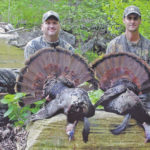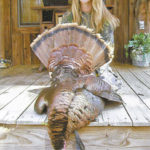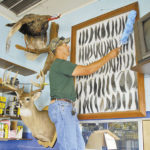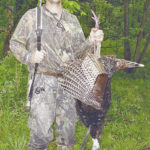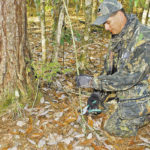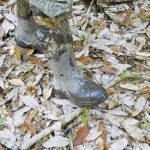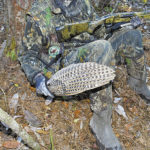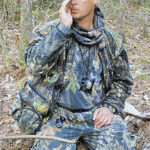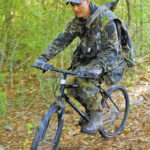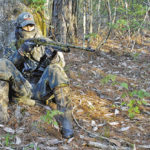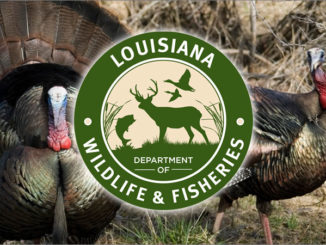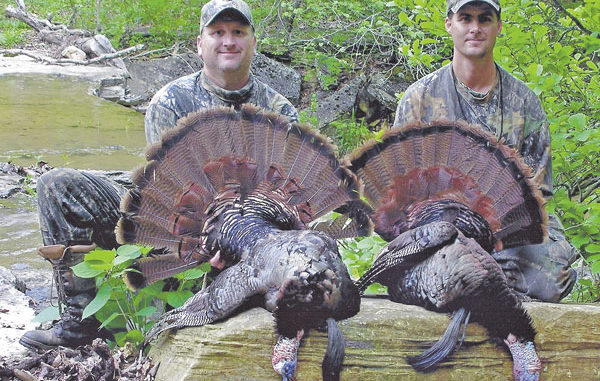
When it comes to pressured gobblers, this public-land hunter has seen and done it all, and he’s had remarkable success.
It’s the 27th day of turkey season. Tim Haik is dressed in camouflage while waiting on customers at Seal’s Auto Service, his service station on the corner of Cleveland and Main Streets in Franklinton. He has missed hunting one day so far.
His season is actually a lot longer than the 30 days that are open in his home state. He starts turkey hunting in Mississippi in mid-March and ends it in mid-May in either Missouri or South Dakota. He will hunt eastern, Rio Grande, Osceola and Merriam’s turkeys in six states during that time.
The service station is a throwback to an earlier time. Here they pump your gas, clean your windshield and check all fluids under the hood. They check your tires’ air pressure on request, and still have free air for their regular customers. Heck — they even fix flats.
Haik is one of Franklinton’s best-known turkey hunters, and everybody who stops at the station seems to know it. The talk is all about turkeys. The small-town atmosphere is still there even though Hurricane Katrina “advanced the town 20 years, population-wise,” to use his words.
The station’s small office is a shrine to Haik’s outdoors passion. A mounted deer and a turkey are there, of course. Gobs of photos are on the wall. And turkey parts — beards and spurred legs — are everywhere. A large framed board with 79 turkey beards hangs over a window, and those are just some of the beards he has collected.
Tomorrow we will be calling turkeys, but this afternoon we are talking. The slender, well-groomed and polite man seems a bit pessimistic for a 43-year-old.
“The pressure on a hunter by his peers to kill a turkey is overwhelming,” he said. “The old style of ethics is gone. In the old days, you pretty much respected the other hunter.
“People will walk in on you or set-up less than a hundred yards away and try to call your turkey. Once they do that, it messes your hunt up. The turkey heads the other way. Some of those people will come back and try to shoot him off his roost.
“It’s gotten too popular. I got into it [25 years ago] before it was popular. Then it exploded. I’ve had people shoot a gun to scare off a gobbling turkey so they can come back another day and kill it.”
Except in Texas, Haik does almost all his hunting on public land. In Louisiana, he hunts on Pearl River, Sherburne and Ben’s Creek Wildlife Management Areas and Bogue Chitto and Tensas National Wildlife Refuges, although he has access to a number of small-acreage private sites as well.
It’s easy to assume that the challenges to which Haik refers come with hunting on public land. But he explains that hunting on private land isn’t a cure either.
“If you’re hunting on private land and someone hears a turkey gobbling, they will slip in on you from where they are,” he said. “Even large private leases have competitive pressure from the club members.”
Loosely quoting World Champion Turkey Caller and call maker Preston Pittman, Haik says that if you can kill a turkey in Mississippi, Louisiana or Alabama, you can kill one anywhere.
“Generation after generation of hunting pressure has made these birds tough to kill,” he said. “I think there are some turkeys that are uncallable.
“I also believe there are some turkeys out there that don’t gobble. The loudmouths that call a lot get killed out.
“All it takes is one time to spook a turkey — call him up and kill his brother beside him. He’s tough to call after that. His brain is only as big as a large marble, but he doesn’t forget.
“A turkey has no curiosity whatsoever. If they see something out of place, they don’t hang around. They won’t even let you drive up near them. They fly or run. Turkeys now are wilder, especially late in the season.”
During the two days that I am with him, Haik shares his tips and techniques for hunting pressured turkeys, wherever they are.
• No. 1: Be patient and persistent. The longer you stay with a turkey, the more likely that you will kill him. Most people will leave if they hear another turkey. Most of the time a pressured turkey will come in silent. If a hunter gets impatient and moves too quickly, he will spook the turkey and make him harder to hunt.
Haik feels that turkeys won’t gobble in their roost trees if they have been pressured a lot. He says he will “lay around for a while” if he knows that turkeys are in the area. A lot of times a pressured gobbler will not start gobbling until 7:30 or 8 a.m.
• No. 2: Do your scouting. Knowing the lay of the land is important. Sometimes a turkey doesn’t want to cross an obstacle, such as a fence, ditch or creek. Even something as simple as a log can hang them up. Also, most of the time a hunter should try to be on the same level as the turkey he’s calling. If he can, he should try to be above the turkey.
Avoid setting up near a ridge. A pressured turkey won’t just come running in over a ridge. If you set up too close to a ridge, all of a sudden just the turkey’s head will pop up over it.
Something to avoid during scouting is preseason calling. Besides being illegal in some states, it is an ideal way to educate turkeys to avoid coming to a call. At the very least if a hunter calls, he should stay far away from the bird. Call just to locate a bird, and then quickly and quietly leave. Don’t call them up to you. You don’t want the bird to see you or even hear your truck in association with a call.
• No. 3: Softer is always better. Always start off calling softly to a turkey. Soft, subtle clucks, purrs and yelps are good. You can always get aggressive with excited yelping and cutting later if you have to. Haik often uses calls that a lot of hunters do not use when working difficult gobblers, including fighting purrs, kee-kee calls and gobbling.
He cautions hunters to be very cautious when gobbling to a turkey, especially on public lands. Other hunters may mistake the caller for a real turkey.
• No. 4: Call to a dominant hen. If a hen answers Haik’s calls, he will typically cut or yelp back at her, imitating whatever she does, trying to aggravate her. If she gets mad enough, she will often close in on the caller, bringing the whole flock with her. The silent gobbler will usually be the last one in.
• No. 5: Hunt food sources. Pressured turkeys have to eat just like any other turkey. Haik actively looks for food sources. He notes that a lot of public lands have food plots planted in clover or chufa. Turkeys will come to these plots every day, so hunting around these areas will increase a hunter’s odds of killing a longbeard.
He cautions that some WMAs in some states prohibit hunting over chufa plots, so it is important to check the specific regulations to see how far away from a food plot a hunter must be to hunt.
Farmland food sources are also important. Turkeys will eat the grain out of cow patties around dairy farms. Beef cattle pastures with white or crimson clover are also good locations to find turkeys. Also, the new growth after a field is burned is attractive to turkeys.
• No. 6: Go the extra mile. Get away from the crowds. Most hunters will hunt close to main roads or trails. Pressured turkeys know where to go to get away from hunters.
Haik says that over the years he has found such places, which he calls “honeyholes” off the beaten path. Turkeys retreat to these areas because of hunter pressure in more accessible areas.
Haik gets some idea of where these places may be by studying maps of the area he will be hunting. Then he uses a bicycle to ride into these remote areas. Most of the public land that he hunts has roads that are gated to motorized vehicles, but are legal and in good enough condition for bike use. It is a lot easier to ride a bike two miles than walk, especially for older hunters.
“During turkey season, my bike stays in the back of my truck,” he says.
Using a bicycle when scouting is also good. It is easy for a hunter to cover five miles in a morning’s scouting.
• No. 7: Try other tactics besides just more calling. Often a pressured turkey will hang up 60 or 70 yards from you. When that happens, Haik will not call at all to the bird. Rather he will scratch in the leaves with his hand or a tree branch. Sooner or later the sound will get the best of the turkey, and he will come in.
Another technique that Haik will use is to flap a dried turkey wing against his thigh, tree limbs or the ground. He describes a turkey’s hearing as “phenomenal,” good enough to easily hear the sound and know what it is.
In areas that have been heavily hunted, it is sometimes best to let the woods wake up on their own rather than use a crow call or owl hoot as a locator call. Every other hunter who has been through the area has probably used them, and a turkey may be wise to them. Sometimes a turkey will respond to a real owl’s hoot, when he won’t to a hunter’s hoot.
Haik will sometimes blow a hawk call or a mallard duck call as a locator call. These are calls that pressured turkeys haven’t learned to associate with hunters.
• No. 8: Stick with mouth calls. Haik firmly believes that they are better. If a hunter can’t sound like a turkey in the woods, he should practice more rather than go to a different kind of call. He does acknowledge that some rare people just may not be able to use mouth calls. If a hunter can’t, he should use a slate call and be subtle with plucks and purrs.
• No. 9: Think like a turkey. Most hunters who use public areas will walk the same trails as others and call from them. Turkeys quickly get used to the routine and refuse to approach a trail. If Haik strikes a bird from a trail, he usually circles around the bird to get behind it before he works it. Pressured birds just won’t approach trails.
• No. 10: Roost your turkey whenever possible. Roosting a turkey is simply finding where a gobbler has flown up into a roost tree for the night. Haik strongly believes that roosting a bird vastly adds to the possibility of success in taking a turkey on public land. It is a successful tactic, says Haik, simply because most hunters will not go to the trouble of roosting the bird.
Turkeys fly up into their roost trees the last 10 minutes or so before dark. During this time, Haik will cackle like a hen because hen turkeys often cackle when flying into and out of a roost tree. If the hunter can use a locator call to get the gobbler to gobble once he is up in the tree, he can study exactly where the bird is located.
Scouting to know the lay of the land beforehand is helpful here. In the hills, turkeys like to roost in large pine trees, and in swamps they seem to prefer big cypress trees. Turkeys also like to roost over water because they feel safer.
The next morning, well before daylight, the hunter should set up very quietly within 100 yards of the roosted gobbler. Setting up close to the bird is important because a skillful hunter will not call a lot to a pressured bird. If the hunter calls too much, the gobbler will just sit right there and wait for the hen to come to him.
• No. 11: Keep your gun up. A lot of hunters tire of holding their shotguns at ready and put them down. Pressured gobblers often approach silently and appear without warning. Moving the gun into shooting position then will almost always result in a disappearing turkey. Haik always keeps his shotgun up on his knees while he is set up.
• No. 12: Try to be invisible. Haik believes that using the right camouflage pattern for the environment he is hunting is important, but thinks that too many hunters spend time chasing the latest camo pattern. Just as important as being invisible is the choice that a hunter makes about where to set up. Too many choose spots where bright sun penetrates the forest overstory and they stick out more than they realize. Haik takes great pains to always set up in a shadowy spot.
Also a consideration is the surrounding cover. Very little surrounding cover also results in the hunter being exposed. Having some trees around is important because a hunter can adjust his position during the fleeting moment that a walking turkey’s head is behind a tree trunk.
But too much cover is as much of a problem as too little. It hinders the ability of the hunter to see and follow the turkey. Worst of all, any vine or branch that is within the swing range of his shotgun can throw off the one and only shot the hunter is likely to get. Haik carefully prunes away any limbs and vines that could interfere with the movement of his shotgun as soon as he sits down.
• No. 13: Don’t depend too much on gadgets. Blinds and decoys work well on turkeys that don’t receive hunting pressure. But pressured turkeys have seen them all. They will hang up at the last minute and not come in. This is especially true for turkeys in fields. Haik never uses blinds or decoys.
